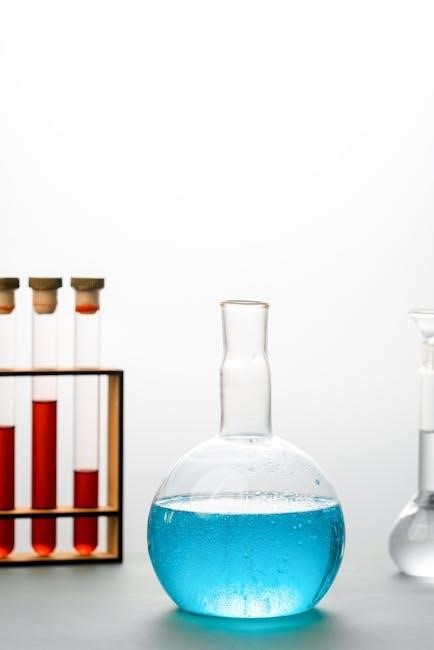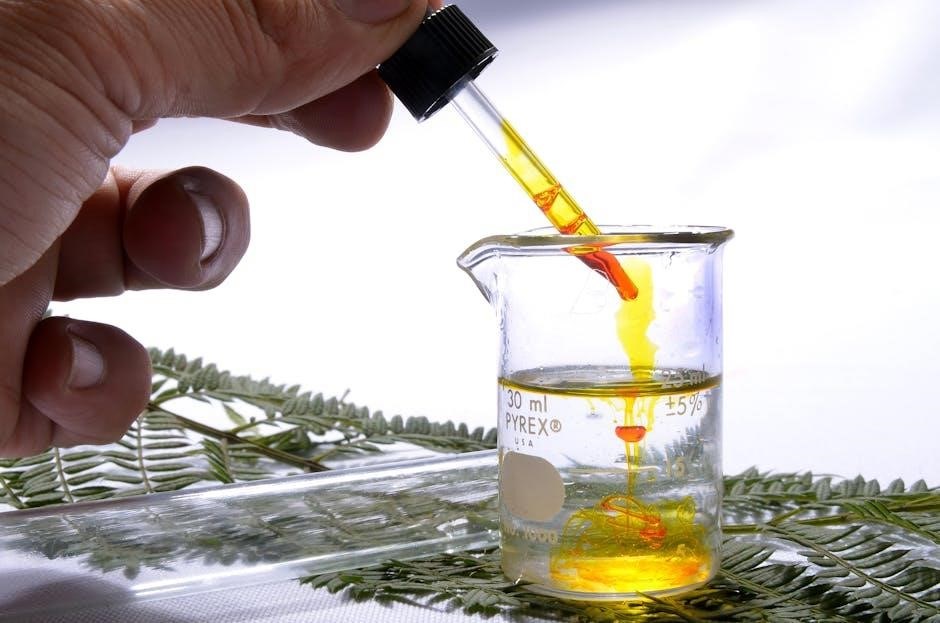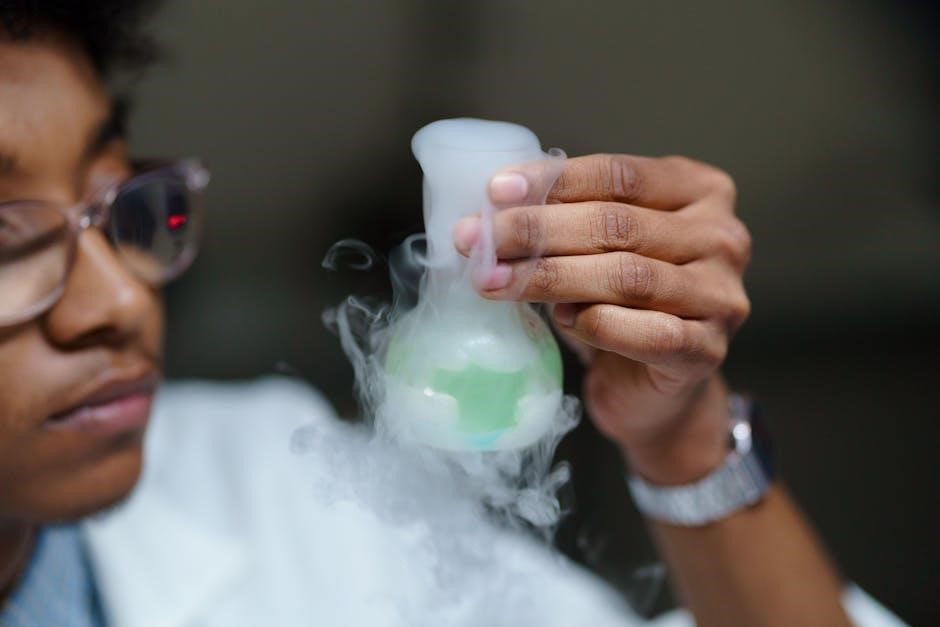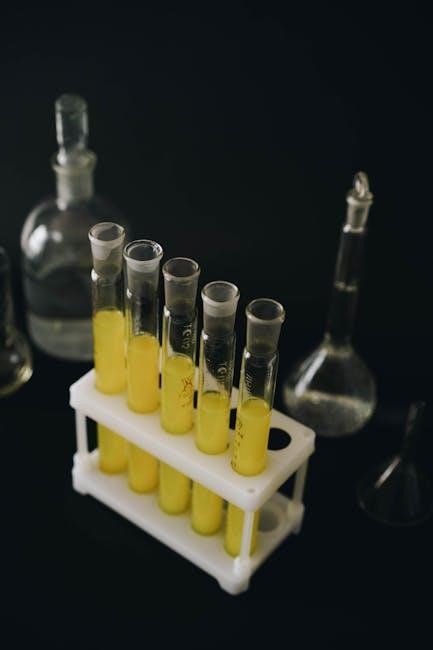A chemical reaction involves the transformation of reactants into products, governed by the law of conservation of mass. Studying reactions helps understand biological processes, industrial applications, and environmental interactions, making it fundamental in chemistry and related fields.
1.1 Definition of a Chemical Reaction
A chemical reaction is a process where one or more substances (reactants) are transformed into new substances (products); It involves the breaking and forming of chemical bonds, often accompanied by observable changes. A balanced chemical equation represents this process, ensuring the law of conservation of mass is upheld. This fundamental concept is essential in chemistry and related fields.
1.2 Importance of Studying Chemical Reactions
Studying chemical reactions is crucial for understanding biological processes, developing industrial applications, and addressing environmental challenges. It provides insights into energy transformations, material synthesis, and the behavior of matter. Mastery of chemical reactions is essential for advancements in fields like medicine, engineering, and sustainable technologies, making it a cornerstone of scientific education and research.

Key Components of a Chemical Reaction
A chemical reaction involves reactants, products, and a chemical equation representing the process. Reactants are the starting materials, while products are the resulting substances after the reaction occurs.
2.1 Reactants and Products
Reactants are the substances consumed during a chemical reaction, found on the left side of the equation. Products are the new substances formed, appearing on the right side. This transformation adheres to the law of conservation of mass, ensuring the total mass remains constant. Understanding reactants and products is crucial for analyzing reaction mechanisms and stoichiometry, aiding in predicting and balancing equations effectively.
2.2 Chemical Equation: A Representation of Reactions
A chemical equation is a symbolic representation of a reaction, showing reactants, products, and their relationship. It uses chemical formulas, arrows, and symbols to convey the process. Balanced equations adhere to the law of conservation of mass, ensuring equal numbers of each atom on both sides. This structured format aids in understanding and predicting reaction outcomes, making it essential for chemical analysis and problem-solving.
Evidence of a Chemical Reaction
Chemical reactions are confirmed by observable changes like color alteration, gas release, precipitate formation, or temperature shifts. These indicators signal a chemical transformation, verifying a reaction’s occurrence.
3.1 Indicators of Chemical Change
Key indicators of chemical change include color changes, release of gas, formation of precipitates, emission of light or sound, and temperature changes. These signs help identify that a reaction has occurred, enabling scientists to verify transformations and study reaction dynamics effectively in laboratory and real-world scenarios.
3.2 Examples of Observable Changes
Observable changes in chemical reactions include the formation of bubbles, vivid color transformations, release of heat or light, and the creation of solids. For instance, mixing baking soda and vinegar produces fizz, while the combustion of hydrogen results in a luminous flame, illustrating clear visual cues of chemical transformations.
Types of Chemical Reactions
Chemical reactions are classified into various types, including synthesis, decomposition, single replacement, double replacement, combustion, and oxidation reactions, each with distinct mechanisms and applications in chemistry.
4.1 Synthesis, Decomposition, Single Replacement, and Double Replacement Reactions
Synthesis reactions combine two or more reactants to form a single product, while decomposition reactions break one reactant into multiple products. Single replacement reactions involve one element displacing another in a compound, and double replacement reactions swap ions between two compounds to form new products. These classifications help organize and predict reaction outcomes in chemistry.
4.2 Combustion and Oxidation Reactions
Combustion reactions involve substances reacting with oxygen, typically producing heat and light, such as burning fuels. Oxidation reactions, a broader category, involve the loss of electrons, often resulting in chemical changes like rust formation. Both are essential in understanding energy production, material degradation, and biological processes, making them critical topics in chemical studies and real-world applications.

Balancing Chemical Equations
Balancing chemical equations ensures the law of conservation of mass is upheld, with equal numbers of each atom on both sides, a critical skill for chemical problem-solving.
5.1 Steps to Balance Equations
Start by listing all reactants and products. Count atoms of each element on both sides. Use coefficients to balance each element systematically, beginning with the most complex molecules. Ensure polyatomic ions are treated as single units. Finally, verify the equation is balanced by checking the total number of atoms on both sides.
5.2 Practice Problems and Common Mistakes
Engage in regular practice to master balancing equations. Common errors include forgetting to balance all elements or miscounting atoms. Start with simple reactions and gradually tackle complex ones. Use online tools or study guides for additional exercises. Pay attention to subscripts and coefficients, ensuring they align correctly for each element.
Stoichiometry in Chemical Reactions
Stoichiometry involves calculating quantities in reactions using mole ratios. It determines limiting reactants and theoretical yields, essential for predicting reaction outcomes and optimizing experiments.
6.1 Mole Ratios and Limiting Reactants
Mole ratios, derived from balanced equations, determine the relative amounts of reactants and products. Identifying the limiting reactant is crucial, as it dictates the maximum yield of products. Calculations involve comparing actual mole ratios to theoretical ones, ensuring efficient use of reactants and accurate predictions of reaction outcomes.
6.2 Calculating Quantities in Reactions
Calculating quantities in reactions involves stoichiometry, using balanced equations to find masses, volumes, or moles of substances. Conversion factors like molar masses and gas laws are essential. For example, multiplying moles by molar mass converts moles to grams. These calculations are vital for predicting yields and optimizing reactions in laboratory and industrial settings, ensuring accuracy and efficiency.
Thermodynamics and Chemical Reactions
Thermodynamics explains energy changes in reactions, classifying them as endothermic (energy absorbed) or exothermic (energy released). Understanding these concepts helps predict reaction direction and feasibility, guiding experimental designs and controlling outcomes.
7.1 Endothermic and Exothermic Reactions
Endothermic reactions absorb energy, often in the form of heat, while exothermic reactions release energy into the surroundings. These classifications help predict reaction outcomes and control systems. Understanding energy flow is crucial in chemistry and engineering, guiding the design of processes and reactions. Examples include photosynthesis (endothermic) and combustion (exothermic), showcasing their importance in natural and industrial contexts.
7.2 Understanding Activation Energy
Activation energy is the minimum energy required for reactants to transform into products. It determines the rate and feasibility of a reaction. Lower activation energy means reactions occur more easily. Catalysts reduce activation energy without being consumed, speeding up reactions. Understanding this concept aids in controlling reaction rates and optimizing processes in chemistry and engineering applications.
Lab Safety and Chemical Reactions
Lab safety is crucial when handling chemicals; Always wear protective gear, follow protocols, and ensure proper ventilation. Handle hazardous materials with care, and dispose of waste safely.
8.1 Essential Safety Protocols
Essential safety protocols include wearing protective equipment like gloves, goggles, and lab coats. Ensure proper ventilation, handle chemicals carefully, and avoid skin contact. Keep emergency equipment nearby, such as fire extinguishers and eye wash stations. Follow procedures for handling hazardous materials and dispose of waste correctly. Always read labels and understand risks before starting experiments.
8.2 Handling Hazardous Chemicals
Handling hazardous chemicals requires assessing risks and following strict guidelines. Store chemicals in labeled, sealed containers in designated areas. Use tongs or gloves to handle corrosive or toxic substances. Contain spills immediately with absorbent materials and neutralize if necessary. Dispose of hazardous waste according to regulations. Always refer to Safety Data Sheets (SDS) for specific handling instructions and emergency procedures.

Tips for Mastering Chemical Reactions
Mastering chemical reactions requires consistent practice, understanding reaction types, and using study guides. Break down complex reactions into simpler steps and review regularly for better retention and clarity.
9.1 Study Techniques and Resources
Effective study techniques for chemical reactions include active learning, flashcards, and practice problems. Utilize online resources, textbooks, and study guides to reinforce concepts. Regular review and structured study plans enhance understanding and retention of reaction types, equations, and balancing methods.
9.2 Solving Practice Problems Effectively
Mastering chemical reactions requires consistent practice. Start with simple problems, gradually increasing difficulty. Break down each problem into steps, identifying reactants, products, and balancing equations. Use study guides and answer keys to verify solutions. Analyze mistakes to improve understanding. Regular practice reinforces concepts and builds problem-solving confidence, essential for excelling in chemical reactions.

Common Misconceptions
Many students mistakenly believe all chemical reactions are explosive or dangerous. Others confuse reaction types or overlook activation energy’s role. Clarifying these misunderstandings enhances understanding and problem-solving skills.
10.1 Myths About Chemical Reactions
A common myth is that all chemical reactions are explosive or dangerous, but many occur slowly and safely; Another misconception is that balancing equations is always straightforward, when in fact it often requires careful adjustment. Some believe catalysts significantly speed up reactions, while others think reactions only occur under extreme conditions. These myths highlight the need for accurate understanding and practical application.
10.2 Clarifying Frequently Confused Concepts
Many confuse endothermic and exothermic reactions, but endothermic absorb heat, while exothermic release it. Another confusion is between reactants and products; reactants are consumed, products are formed. Some mix up chemical and physical changes—chemical changes involve new substances. Clarifying these concepts enhances understanding and problem-solving in chemistry, ensuring accurate application of principles in various scenarios and experiments.
Mastering chemical reactions is essential for understanding chemistry. By studying types, balancing equations, and applying stoichiometry, students gain foundational knowledge, enabling success in advanced scientific fields and practical applications.
11.1 Summary of Key Concepts
11.2 Final Tips for Success
To master chemical reactions, practice balancing equations regularly, use flashcards for key terms, and review stoichiometry. Focus on understanding reaction types and evidence of change. Engage with study guides and online resources for interactive learning. Stay organized, ask questions, and apply concepts to real-world scenarios. Consistent effort and proactive learning will ensure long-term success in this fundamental area of chemistry.
